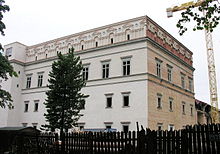Grand Prince's Palace in Vilnius
The Grand Duke's Castle (also Royal Castle ) of Vilnius (Lithuanian: Valdovų rūmai ) was a residential palace of the Polish-Lithuanian rulers, which was destroyed at the beginning of the 19th century and reconstructed after the turn of the millennium. The reconstructed building was opened in 2013 as a museum and as a location for festive events.
history
The originally Gothic building was largely due to Alexander Jagiello and Sigismund I, the ancients . The Italian architects Bartolomeo Berrecci da Pontassieve, Giovanni Cini da Siena, Bernardino de Gianotis Zanobi, who work in Poland and Lithuania, were involved in the construction and redesign in the Renaissance style .
In the 17th century there was a Baroque transformation, in which Matteo Castello, Giacopo Tencalla and others participated.
In 1655 a Russian army captured Vilnius. Although it was reconquered six years later, the palace, looted and half-destroyed by fire, was not rebuilt. Parts of the castle remained inhabited. After Lithuania was incorporated into the tsarist empire, the demolition of the remains of the castle was ordered in 1801.
Since 1987 the site of the old castle has been excavated; the foundations and numerous finds such as coins, shards, floor tiles and parts of the decor of the facades came to light. The finds exceeded all expectations and suggested a reconstruction. In 2000, Parliament decided to rebuild.
Since 2002, with the aim of strengthening Lithuania's patriotic identity, the castle has been reconstructed - regardless of the reservations of numerous historians and experts, who criticize the use of modern building materials and techniques, among other things.
In 2013 the castle was opened as a museum and as a place for ceremonial events. For the interior, which was completely lost and ultimately unknown, furniture, paintings, small sculptures and even tableware were bought together on the international antiques market. An archaeological exhibition was set up in the basement of the castle, in which the finds and foundations, the only original parts of the castle, can be viewed. The Lithuanian public criticized the cost of the reconstruction, which also meant that authentic architectural monuments of the city continued to deteriorate, even in the immediate vicinity of the new castle.
literature
- Arnold Bartetzky: The main thing, the historical impression is correct: Stone self-compensation: Two hundred years after the destruction, the palace of the Lithuanian grand princes was rebuilt in Vilnius , in: Frankfurter Allgemeine Zeitung October 24, 2012, page 29.
Web links
- The palace
- Lithuanian Ducal Palace
- Site about the reconstruction
- Donation fund
- Critical German newspaper report
Individual evidence
- ↑ Arnold Bartetzky: The main thing is that the historical impression is correct: Stone self-compensation: Two hundred years after the destruction, the palace of the Lithuanian grand dukes was rebuilt in Vilnius , in: Frankfurter Allgemeine Zeitung October 24, 2012, page 29.
- ↑ Arnold Bartetzky: The main thing is that the historical impression is correct: Stone self-compensation: Two hundred years after the destruction, the palace of the Lithuanian grand dukes was rebuilt in Vilnius , in: Frankfurter Allgemeine Zeitung October 24, 2012, page 29.
Coordinates: 54 ° 41 ′ 9.1 ″ N , 25 ° 17 ′ 20.3 ″ E










